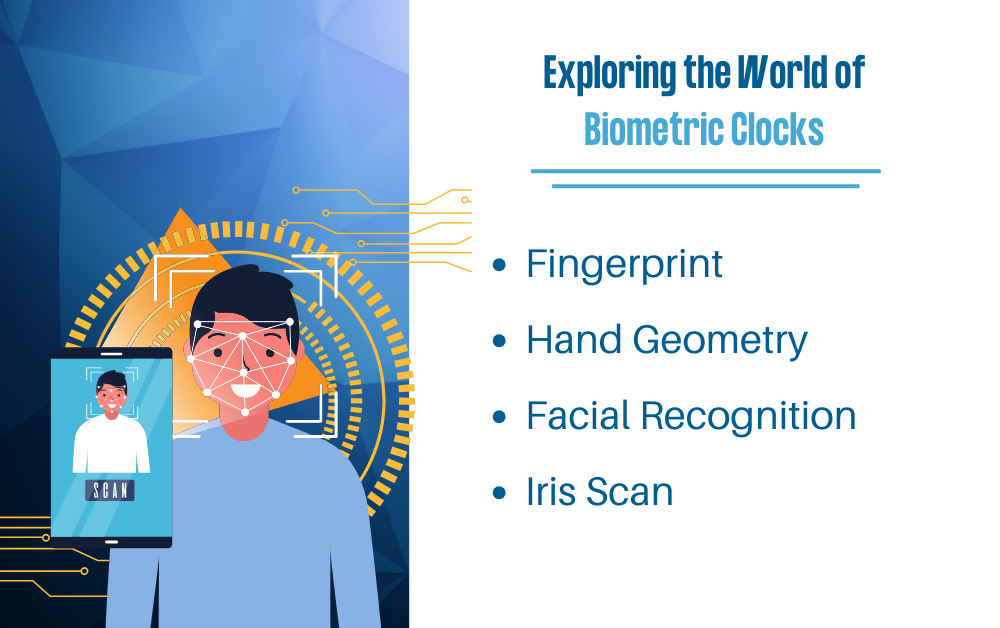Imagine a world where clocks don’t just tell time but also recognize you at a glance. Welcome to the era of biometric clocks, where timekeeping meets cutting-edge technology. In this blog post, we’ll take a deep dive into the fascinating realm of biometric clocks, exploring how they work and the various types available.
Fingerprint Biometric Clocks
What They Are
Fingerprint biometric clocks are devices that authenticate individuals based on their unique fingerprints. Each person’s fingerprint is distinct, making it an ideal identifier. These clocks are equipped with sensors capable of capturing even the smallest ridges and valleys of a fingerprint.
How They Work
When a user places their finger on the sensor, the biometric clock captures an image of the fingerprint. This image is then converted into a digital template by analyzing key features such as ridge endings and bifurcations. The template is compared against a database of stored templates for authentication.
Pros:
– High level of accuracy: Fingerprint patterns are highly unique, resulting in reliable authentication.
– Quick and convenient authentication process: Users can authenticate themselves with a simple touch, minimizing waiting times.
Cons:
– Susceptible to false positives/negatives in case of dirty or damaged fingerprints.
– Limited scalability for large organizations due to the need for individual fingerprint enrollment.
Hand Geometry Biometric Clocks
What They Are
Hand geometry biometric clocks analyze the shape and size of an individual’s hand for identification purposes. These clocks capture various measurements, including finger length, width, and knuckle depth.
How They Work
When a user places their hand on the scanner, the biometric clock captures an image of the hand’s geometry. This image is then analyzed to extract key measurements and create a unique hand template. The template is compared against stored templates for authentication.
Pros:
– Non-intrusive and user-friendly: Users simply place their hand on the scanner for authentication.
– Relatively low cost compared to other biometric methods: Hand geometry systems are often more affordable to implement.
Cons:
– Less accurate than fingerprint or iris scans: Hand geometry can be affected by changes in hand position or environmental factors.
– Vulnerable to environmental factors such as changes in lighting or hand position.
Facial Recognition Biometric Clocks
What They Are
Facial recognition biometric clocks identify individuals based on their facial features, such as the distance between eyes, nose, and mouth. These clocks use advanced algorithms to analyze facial patterns.
How They Work
When a user stands in front of the camera, the biometric clock captures an image of their face. This image is then processed to create a unique facial template, which is compared against stored templates for authentication.
Pros:
– Contactless and hygienic authentication method: Users don’t need to touch the device for authentication.
– Can work well in various lighting conditions: Facial recognition systems are designed to adapt to different lighting environments.
Cons:
– Less secure than other biometric methods: Facial features can change over time, and facial recognition systems can be vulnerable to spoofing attacks using photos or videos.
– May raise privacy concerns due to the collection and storage of facial data.
Iris Scan Biometric Clocks
What They Are
Iris scan biometric clocks identify individuals based on the unique patterns in their irises. The iris, which is the colored part of the eye, contains intricate patterns that are unique to each individual.
How They Work
Iris scan biometric clocks use near-infrared light to capture a high-resolution image of the user’s iris. The captured image is then analyzed to extract iris patterns, which are converted into a digital template. This template is compared against stored templates for authentication.
Pros:
– Extremely high level of accuracy: Iris patterns are highly distinctive, resulting in reliable authentication.
– Difficult to spoof or replicate: Iris scans are difficult to forge, enhancing security.
Cons:
– Requires close proximity to the device for scanning: Users need to position their eyes close to the scanner for authentication.
– Can be uncomfortable for some users due to the need for close eye contact with the scanner.
Conclusion
In conclusion, biometric clocks offer a revolutionary way to manage time and attendance, combining accuracy with convenience. Whether it’s fingerprint, hand geometry, facial recognition, or iris scan, each type of biometric clock has its unique strengths and limitations. By understanding these differences, organizations can choose the right biometric solution to meet their needs.
Unlock the Future of Timekeeping Today!
Ready to embrace the future of timekeeping? Whether you’re a small or medium-sized business (SMB) seeking streamlined attendance tracking or a large enterprise in need of cutting-edge solutions, BCM Payroll can help. With expertise in biometric clocks and payroll management, we offer tailored solutions for accurate, efficient, and compliant timekeeping. Let us handle the complexities of time management so you can focus on growing your business. Contact us today to learn how BCM Payroll can empower your organization with advanced biometric clock solutions and comprehensive payroll services.

